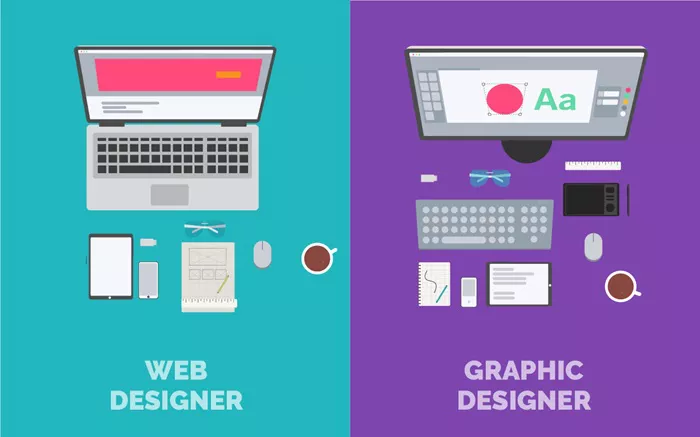In the realm of digital creativity and visual communication, two prominent fields stand out: graphic design and web design. Both are integral to the modern digital landscape, yet they serve distinct purposes and require unique skill sets. Whether you’re aspiring to enter these fields professionally or seeking to understand which path aligns best with your goals, this article will provide a comprehensive comparison of graphic design and web design.
1. Introduction to Graphic Design and Web Design
Graphic design and web design are both disciplines within the broader spectrum of visual communication. While they share common roots in design principles and creativity, their applications and focuses diverge significantly.
Graphic Design: Defining Visual Communication
Graphic design revolves around creating visual content to communicate messages. It involves the use of typography, imagery, color theory, and layout techniques to convey ideas or information. Graphic designers work across various mediums, including print, digital, advertising, and branding.
Web Design: Crafting User-Focused Digital Experiences
Web design, on the other hand, centers on the creation of websites and web applications. It encompasses both the aesthetic aspects of design and the functional aspects of user experience (UX) and user interface (UI) design. Web designers integrate visual elements with interactive elements to enhance usability and engagement.
2. Skill Requirements and Expertise
Graphic Design Skills:
Mastery of design software like Adobe Photoshop, Illustrator, and InDesign.
Understanding of typography, color theory, and composition.
Ability to create visually appealing graphics, logos, posters, and other print or digital materials.
Knowledge of branding principles and visual identity design.
Web Design Skills:
Proficiency in front-end web development languages such as HTML, CSS, and JavaScript.
Understanding of UX/UI design principles and usability best practices.
Familiarity with responsive design techniques for different devices and screen sizes.
Ability to collaborate with developers and stakeholders to implement design solutions.
3. Career Opportunities and Industry Demand
Graphic Design Career Pathways:
Print Design: Designing for physical media such as magazines, books, packaging, and advertisements.
Digital Design: Creating graphics and visuals for online platforms, social media, and digital marketing campaigns.
Brand Identity: Developing logos, brand guidelines, and visual identities for companies and organizations.
Web Design Career Pathways:
UI/UX Design: Designing intuitive and user-friendly interfaces for websites and applications.
Front-End Development: Implementing designs using HTML, CSS, and JavaScript to create interactive web experiences.
E-commerce Design: Optimizing user flows and designing interfaces for online shopping platforms.
4. Creativity vs. Functionality: Balancing Design Objectives
Graphic Design Focus:
Graphic designers prioritize aesthetic appeal and visual storytelling. They leverage design principles to evoke emotions, convey messages, and enhance brand recognition through visually compelling content.
Web Design Focus:
Web designers combine creativity with functionality. They focus on creating seamless user experiences by ensuring intuitive navigation, clear information architecture, and engaging interactions across digital platforms.
See also:Distributing Hostinger Webmail: A Comprehensive Guide
5. Educational Paths and Training
Graphic Design Education:
Formal education in graphic design often includes degrees or certificates in graphic arts, visual communication, or digital design.
Courses cover design theory, software proficiency, typography, and portfolio development.
Web Design Education:
Web design education encompasses a blend of design principles and technical skills.
Programs may include courses in UX/UI design, front-end development, responsive design, and content management systems (CMS).
6. Future Trends and Industry Evolution
Graphic Design Trends:
Emphasis on minimalist design, bold typography, and sustainable design practices.
Integration of augmented reality (AR) and immersive experiences in digital and print media.
Web Design Trends:
Focus on mobile-first design and accessibility standards.
Adoption of motion design, micro-interactions, and advanced CSS/JavaScript frameworks for dynamic web experiences.
Conclusion
In conclusion, whether you choose graphic design or web design depends largely on your interests, career goals, and preferred working environment. Both fields offer rewarding opportunities for creative expression and professional growth. Graphic design excels in visual storytelling and brand communication, while web design focuses on creating interactive and user-centric digital experiences. Ultimately, understanding the distinctions between these disciplines will guide you toward a fulfilling career in the vibrant world of design.
By exploring the nuances of graphic design and web design, aspiring designers can make informed decisions that align with their passions and aspirations in the dynamic landscape of digital creativity.
Related topics:
- Guide On How To Cancel A PayPal Payment
- The 6 Best Free SEO Tools
- How To Check How Many Backlinks A Website Has

